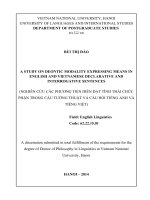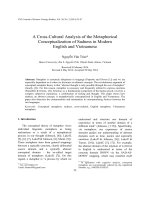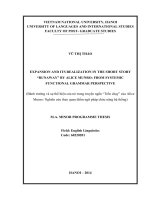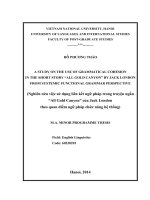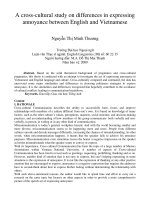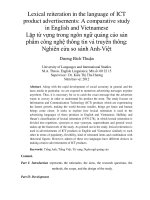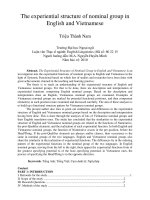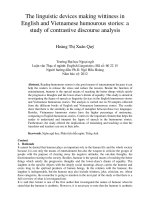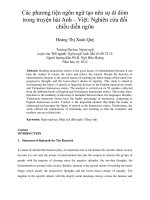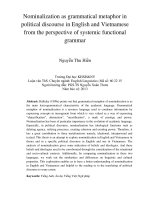Moon adjuncts expressing the degree of intensity in sports commentaries in english and vietnamese in the perspectives of systemic functional grammar (tt)
Bạn đang xem bản rút gọn của tài liệu. Xem và tải ngay bản đầy đủ của tài liệu tại đây (489.57 KB, 32 trang )
THE UNIVERSITY OF DANANG
UNIVERSITY OF FOREIGN LANGUAGE STUDIES
LỤC THỊ LƯU Ý
MOOD ADJUNCTS EXPRESSING THE DEGREE OF
INTENSITY IN SPORTS COMMENTARIES IN
ENGLISH AND VIETNAMESE IN THE PERSPECTIVES
OF SYSTEMIC FUNCTIONAL GRAMMAR
Major : ENGLISH LINGUISTICS
Code : 822.02.01
MASTER THESIS
IN FOREIGN LANGUAGES - LITERATURE AND CULTURE
(A SUMMARY)
Da Nang, 2018
This thesis has been completed at
University of Foreign Language Studies, The University of Da Nang
Supervisor : Dr. Ngũ Thiện Hùng
Examiner 1: Assoc. Prof. Dr. Nguyễn Văn Long
Examiner 2: Assoc. Prof. Dr. Nguyễn Tất Thắng
The thesis will be orally defended at the Examining Committee
Time: 27th October, 2018
Venue: University of Foreign Language Studies – The University
of Da Nang
This thesis is available for the purpose of reference at:
- Library of University of Foreign Language Studies, The
University of Da Nang.
- The Information Resources Center, The University of Da Nang.
-1Chapter One
INTRODUCTION
1.1. RATIONALE
It is said that a healthy nation is always a wealthy nation;
therefore, it is necessary to put emphasis on sports. One can think of
a healthy mind only in a healthy body. Both physical and mental
being well are the prerequisites of great achievements in man’s life.
As a result, sports play an important role in the development of each
country all over the world. That is the reason why there is an
increasingly number of national and international competitions
taking place every year. Thus, the role of the commentators is very
important. They have to provide commentaries about the game and
to entertain at the same time. They have to deal with the unfolding
events on the pitch linguistically without hesitation. The nature of
their job and the unusual linguistic setting is what makes their speech
so specific and to bring interesting matches to audiences.
Like whatever, sports also have its spirit and rhythm. It is the
commentaries made by commentators that not only contribute to
make matches become more vivid, but also help people follow the
match conveniently. There is no doubt that it is so difficult for the
commentators to produce such an attractive commentary, especially,
to employ precise language so as to interpret and evaluate exactly the
spirit of the running matches. I wonder in what way the
commentators can transform different situations and attract his
audiences’ attention into what is happening effectively? What kind
of language he use? These questions actually capture my attention.
-2Besides quick observation skill, comprehension about sport
and an emotive voice, it is essential for commentators to know how
to use of language so that they can analyze unexpected situations,
express the scale of different kinds of feelings most impressively and
direct people up to the competition. As a result, the introduction of
Appraisal theory is necessary to meet this demand.
Appraisal theory is an emerging aspect in linguistic research, which
has attracted many linguists over the world in recent years. Appraisal
theory concerns with the interpersonal meaning in language, with
subjective presence of writer / speakers in texts as they adopt stances
toward both the material they present and those with whom they
communicate (Martin & White, 2005). The Appraisal framework has
a ramified structure allowing it to recognize even slight expressions
of attitude. Three main categories of the framework are Attitude
which is concerned with our feelings, including emotional reactions,
judgments of behavior and evaluation of things (Martin & White,
2005), Engagement which is directed towards identifying the
particular dialogic positioning associated with given meanings and
towards describing what is at stake when one meaning rather than
another is employed (Martin & White, 2005), and Graduation which
deals with grading phenomena whereby feelings are amplified and
categories blurred (Martin & White, 2005).
Each category has its subcategories which are responsible for various
evaluative functions. In particular, Force is one of the two
subsystems of Graduation which covers assessments as to degree of
intensity and as to amount. In the sport commentaries, the degree of
intensity can be realized via quality and process. It is undeniable that
-3so far there has been several studies conducted involving in the
language of evaluation; however, the number of deep researches in
terms of intensification in sport commentaries carried out is not so
many.
For all reasons mentioned above, I decided to do the research entitled
“Mood Adjuncts Expressing the degree of Intensity in Sport
Commentaries in English vs. Vietnamese in the Perspectives of
Systemic Functional Grammar”. I hope this paper is expected to
help Vietnamese learners of English achieve better comprehension in
the degree of intensity expressed in sport commentaries in English
and Vietnamese as well as to benefit to those who are interesting in
this topic with a good resource of reference.
1.2. AIMS AND OBJECTIVES
1.2.1. Aims
The study aims at investigating Mood Adjuncts expressing
the degree of intensity in sport commentaries based mainly on the
theory of Appraisal and Functional Grammar. The study also focuses
on finding the differences and similarities of Mood Adjuncts
expressing intensification in terms of semantic and syntactic features
between English and Vietnamese. The findings of this study
contribute to the better comprehension in evaluative language used in
entertainment context.
1.2.2. Objectives
To achieve the aims of the study, the following objectives
are intended to:
-4-
To identify and describe types of Mood Adjuncts expressing
the degree of intensity in sport commentaries in terms of
semantic and syntactic features in Vietnamese and English;
-
Find out the similarities and differences in using Mood
Adjuncts expressing the degree of intensity in English and
Vietnamese sport commentaries in terms of semantic and
syntactic features in Vietnamese and English;
1.3. SCOPE OF THE STUDY
The study primarily focuses on the analysis of Mood
Adjuncts expressing the degree of intensity in the sport
commentaries. Particularly, the study investigates the language in
terms of syntactic and semantic features in the perspective of
Functional Grammar and Appraisal framework respectively. The
description of the syntax of Mood Adjuncts is made in reference to
the functional framework in terms of clause as exchange along with
their syntactic realizations. The examination of the semantics of
Mood Adjuncts is done with a look into the semantic categories
based on Appraisal framework. Repetition and Infusion - two of
modes of intensification- is not investigated.
In spite of a lot of stylistic devices used in sport
commentaries, it will not be mentioned here.
1.4. RESEARCH QUESTIONS
Based on research objectives, this research is formulated in
the following questions:
-51. What are the syntactic features of Mood Adjuncts expressing
the degree of Intensity in sport commentaries in the view of
Functional Grammar?
2. What are the semantic features of Mood Adjuncts expressing
the degree of Intensity in sport commentaries in the view of
Appraisal theory?
3. What are the similarities and differences of Mood Adjuncts
expressing the degree of Intensity in sport commentaries in
terms of syntactic and semantic features between English
and Vietnamese?
1.5. SIGNIFICANCE OF THE STUDY
The findings of the study is expected to help the Vietnamese
and English learners, language users, especially commentators
understand the language expressing the degree of intensity within
different situations used in sport commentaries so that they can have
an interesting commentary on a running match. Learners and readers
of English can acquire the semantic values of graduation as well as
the linguistic realizations, and then they can apply it in social life.
This study is also a beneficial reference for further researches.
1.6. ORGANIZATION OF THE STUDY
This study consists of 5 main chapters as follows:
Chapter 1: “Introduction”
Chapter 2: “Literature review”.
Chapter 3: “Methods and Procedures”
Chapter 4: “Findings and Discussion”
Chapter 5: “Conclusion and Implications”
-6Chapter Two
LITERATURE REVIEW AND THEORETICAL
BACKGROUND
2.1. LITERATURE REVIEW
Rothery & Stenglin (2000) discussed the role of Appraisal in
interpreting literature. “On possible factors in the aesthetic
appreciation of metaphors” by Csatár, Pethó, and Tóth (2006)
revealed that aesthetic judgments concerning metaphors are
mECsurable to some extent.
Veissier, Boissy, Désiré and Greiveldinger (2009) borrowed
appraisal theories developed in cognitive psychology to study sheep
emotions. Emotions are viewed as the result of how an individual
evaluates a triggering situation, following a sequence of checks,
including the relevance of the situation (its suddenness, familiarity,
predictability, and intrinsic pleasantness), its implications for the
individual (including consistency with the individual’s expectations),
the potential for control, and both internal and external standards.
They assumed that if the outcome of checks has an impact on the
animal’s emotional responses, then animals do not only show
emotional responses but also feel emotions. This study showed that
sheep use similar checks to those used by humans to evaluate their
environment, for example suddenness, familiarity, predictability,
consistency with expectations, and control. Furthermore, the
evaluation affects their emotional responses (behavioural responses,
-7such as startle, ear postures, and cardiac activity). It is concluded that
sheep are able to experience emotions such as fear, anger, rage,
despair, boredom, disgust and happiness because they use the same
checks involved in such emotions as humans. For instance, despair is
triggered by situations which are evaluated as sudden, unfamiliar,
unpredictable, discrepant from expectations, and uncontrollable,
whereas boredom results from an overly predictable environment,
and all these checks have been found to affect emotional responses in
sheep.
Karen & Philippe (2014) applied Appraisal Theory to
determine the intensity and duration which are two central
characteristics of an emotional response. The goal of the present
study is to explain a systematic empirical study comparing predictors
of emotion intensity and duration. Participants were asked to recall
recently experienced episodes of anger, fear, disgust, guilt, sadness,
and shame. Subsequently, they were asked to answer a number of
questions regarding (a) the intensity and duration of these emotions,
(b) their appraisal of the emotion-eliciting event, and (c) their use of
a wide range of regulation strategies. Emotion intensity was found to
be mainly predicted by appraisals whereas emotion duration was
equally well predicted by appraisals and regulation strategies.
Many Vietnamese researchers also have concerns with the
Appraisal theory. For example,
Hồ Lộng Ngọc (2006) disclaimed markers in English and
Vietnamese in view of Appraisal. The study investigated a wide
-8range of linguistic devices to mark the speakers / writers’ disclaim
with different structures of verbs, adverbs, adjectives and nouns in
the two languages.
Together with studies based on Appraisal Theory, Lê Thị Hà
(2014) used the Appraisal framework developed by Martin & White
(2005) to analyze evaluative language used in English and
Vietnamese love letters. Her overall purpose was to find out the
similarities and differences between the two languages in the use of
patterns of Appraisal to express love feelings. The findings obtained
from the data analysis of 60 love letters show that Affect, a sub-type
of Attitude, was the most prominent in both English love letters and
Vietnamese love letters. The thesis provided readers with useful
knowledge of using sub-systems of Appraisal in translating and
writing letters in general and love letters in particularly.
Trần Hữu Thuần (2013) conducted a study on the syntactic
and semantic features of Appreciation in football commentaries in
English and Vietnamese. Based on the Appraisal Theory, the author
provided Vietnamese learners with pragmatic knowledge and the use
of appreciation effectively in communication and translation. In
addition, the study brought practical benefits for those who wanted to
use appreciation in English and Vietnamese as far as the appreciation
in football commentaries was concerned.
Cái Kim Nhung (2016) carried out Graduation used in
advertising of cosmetics in English and Vietnamese in form of the
-9syntactic features of phrases, in semantic view of Appraisal Theory
as well as in pragmatic view of Speech Acts. The study is both
quantitative and qualitative. The thesis focused on analysing and
contrasting Graduation used in advertising of cosmetic in English
and Vietnamese. This study revealed that Graduation used in
advertising of cosmetics were syntactically found in form of noun
phrases, verb phrases, adjective phrases as well as adverb phrases.
Semantically, Graduation was used in advertising of cosmetics in
English and Vietnamese as modes of force and of focus.
Additionally, Graduation was pragmatically found in boosting
illocutionary force of representative and of directive in advertising of
cosmetics in English and Vietnamese. The study also pointed out the
similarities and differences between Graduation used in advertising
of cosmetics in English and Vietnamese in terms of syntactic and
semantic features.
In short to this section, there have been several aspects of
Appraisal researched in many studies above. However, the degree of
intensity in sport commentaries is not still explored. This study is
conducted with the expectation that it will help Vietnamese learners
of English better understand the use of Intensification in
commentary.
- 10 2.2. THEORETICAL BACKGROUND
2.2.1. Appraisal Theory
2.2.2. Intensification and Modes of Intensification
2.2.3. An Overview of Functional Grammar
Ideational metafunction
Interpersonal metafunction
Textual metafunction
2.2.3.1. The Mood Element
2.2.3.2. Adjunct
2.2.3.1. Mood Adjuncts
Chapter Three
RESEARCH METHODS AND METHODOLOGY
3.1. METHODOLOGY
This study makes use of quantitative and qualitative research
design employing descriptive and comparative method.
Quantitative method is aimed to classify types of
intensification and count the number of commentaries in each type to
determine which kind of intensification is popular in English and
Vietnamese commentaries
It is qualitative because it explores linguistic information
such as linguistic features in terms of syntactic and semantic
categories/subcategories from the qualitative data. Particularly, the
Functional grammar and Appraisal framework is used to analyze
language of the degree of intensity. Then, comparative method
- 11 applied is to look for the differences and similarities of language
expressing the degree of intensity in English and Vietnamese sport
commentaries.
3.2. SAMPLING OF THE STUDY
The degree of intensity is expressed by Mood Adjuncts
which are recognized in the form of Adverbs.
The sampling of the study is done in terms of football with
150 English and 150 Vietnamese commentaries in 2017.
3.3. DATA COLLECTION
3.3.1. Instruments of Data Collection
After being collected and examined, instances of Mood
Adjuncts will be analyzed in terms of grammatical realizations and
semantic features. Afterwards, there will be a contrastive analysis to
find out the similarities and differences in English and Vietnamese
sport commentaries.
3.3.2. Procedures of Data Collection
The steps for collecting data included:
-
To collect data of expressing the degree of intensity in
English and Vietnamese sport commentaries in Internet,
newspapers, magazines and so on.
-
To describe the syntactic features of Mood Adjuncts based
on Functional Grammar System.
-
To identify the semantic features of intensification in both
English and Vietnamese sport commentaries.
- 12 -
To discover similarities and differences in the use of Mood
Adjuncts to express the degree of intensity in both English
and Vietnamese sport commentaries.
The sport commentaries are randomly collected from the
following newspapers, magazines and websites:
3.3.3. Data analysis
Mood Adjuncts expressing the degree of intensity in sport
commentaries are analyzed in terms of these following aspects:
Semantic features of intensification in the view of Appraisal
Theory.
Grammatical realizations of mood adjuncts in the view of
Functional Grammar.
3.4. VALIDITY AND RELIABILITY
Chapter Four
FINDINGS AND DISCUSSIONS
This chapter aims to present the findings and discussion of
Mood Adjuncts expressing the degree of intensity used in sport
commentaries in English and Vietnamese in terms of syntactic and
semantic features.
4.1.
SYNTACTIC
FEATURES
OF
MOOD
ADJUNCTS
EXPRESSING THE DEGREE OF INTENSITY USED IN
SPORT COMMENTARIES IN ENGLISH AND VIETNAMESE
IN THE VIEW OF FUNCTIONAL GRAMMAR
Table 4.1. The Frequency Rates of Adverbs Expressing the degree of
Intensity Used in sport commentaries in English (ECs) and in
Vietnamese (VCs)
- 13 Mood Adjuncts
ECs
VCs
expressing the
Occurrence
Rate
Occurrence
Rate
Degree of Intensity
Pre-
Noun
12
8%
31
22%
modifier
Adjective
43
29%
72
48%
Adverb
5
3%
0
0%
90
60%
47
30%
150
100%
150
Verbal
group
Total
100
%
4.1.1 Mood Adjuncts of Intensity used as pre-modification of an
Adjective
Burnley
are
extremely
Subject
Predication
Noun
Copula
pre-mod
Adjunct
Mood
Adjunct
deep
Complement
Adjective
at
the
moment as
they...
moments.
Adjunct
Prep
phrase
MOOD
RESIDUE
Figure 4.1: Thematic Structure of Mood Adjunct of Intensity
used as pre-modification of an Adjective in English Commentaries
Pha va bóng
Subject
vơ cùng
pre-mod
nguy hiểm
Complement
của tiền vệ
mang áo số 8
bên phía Thái
Lan.
Adjunct
- 14 Adjunct
Mood Adjunct
Adjective
Prep phrase
MOOD
RESIDUE
Figure 4.2: Thematic Structure of Mood Adjunct of Intensity
Noun
used as pre-modification of an Adjective in Vietnamese
Commentaries
4.1.2. Mood Adjuncts of Intensity used as pre-modification of an
Adverb
The
Portuguese
Is
quite
clearly
Sub
Predicator
Adjunct
N
Copula
premod
Adjunct
Mood
Adjunct
frustrated
as his,
... San
Mames
Comp
Adjunct
Manner Adjective Adverb
Adverb
phrase
MOOD
RESIDUE
Figure 4.3: Structure of Mood Adjunct of Intensity used as
pre-modification of an Adverb in English Commentaries
- 15 4.1.3. Mood Adjuncts of Intensity used as pre-modification of a Noun
City
Had
a little
scare
earlier in the half but
have otherwise been in
control
Adjunct
Adverb phrase
Sub
Finite
Pred
Pre-mod Adv
Comp
Noun
V
Mod Adj
Noun
MOOD
RESIDUE
Figure 4.4: Structure of Mood Adjunct of Intensity little used as pre-modification of a Noun in
English Commentaries
thủ quân Lionel
Messi
Chính
Pre-mod
Adverb
Mood
Adjunct
mới
người chỉ đạo đồng đội
là
thi đấu.
Subject
Adjunct
Finite/Pred
Comp
Noun
Adverb
Verb
NP
MOOD
RESIDUE
Figure 4.7: Structure of Mood Adjunct of Intensity Chính used as pre-modification of a Noun in
Vietnamese Commentaries
- 16 4.1.4. Mood Adjuncts of Intensity used as modifier to verbal group
The cross into the Almost
finds
the towering
although the striker
middle
Gestede
... unscathed
Subject
Modifier
finite
Predicator
Complement
Adjunct
Noun
Mood Adjunct
Verb
Noun
Adverbial Clause
MOOD
RESIDUE
Figure 4.11: Structure of Mood Adjunct of Intensity almost used as modification of a Verbal Group
in English Commentaries
Trong các trận
đấu trước,
đội tuyển
Việt Nam
Adv
Adverb phrase
Subject
Noun
MOOD
chỉ
Modifier
Mood
Adjunct
chơi
finite
Pred
Verb
bóng kiểm sốt
và áp đặt lối
chơi
Complement
Noun
lên phần sân
của đối
phương.
Adjunct
Adv Phrase
RESIDUE
4.1.5. Summary
4.2 SEMANTIC FEATURES OF MOOD ADJUNCTS EXPRESSING THE DEGREE OF
INTENSITY USED IN SPORT COMMENTARIES IN ENGLISH AND VIETNAMESE APPRAISAL
THEORY
- 17 4.2.1. Mood Adjuncts expressing the degree of intensity Used in Sport commentaries as Force
4.2.1.1. Mood Adjuncts Up/ Down Scaling of qualities
4.2.1.2. Mood Adjuncts Up/ Down Scaling of verbal processes
Table 4.2:. Summary of Mood Adjuncts as Isolated Intensification used in Englsih Sport commentaries
Category
Linguistic realization
of
Raw
Example
%
Number
Evaluation
QUALITY
completely
Leicester are completely rampant
2
1.3
really
it is really poor defending from ...
8
5.3
fully
They are fully deserving of their ..
2
1.3
extremely
Burnley are extremely deep
3
2
absolutely
Klopp was absolutely furious.
7
4.6
entirely
Lloris is not entirely convincing
2
1.3
relatively
.. which is relatively rare in …
1
0.6
hardly
Bayern are hardly going to be ….
1
0.6
- 18 -
PROCESS
very
Verygood defending from Hummels
2
1.3
actually
The … Moreno has actually ….
1
0.6
A little
A little worrying for the hosts..
3
2
rather
it was rather too close to Ryan
2
1.3
even
it was even more suited
1
0.6
almost
I am almost lost for words here
7
4.6
just
Just incredible scenes here.
3
2
pretty
The angle is pretty tight
7
4.6
slightly
Benitez …. slightly hamstrung
3
2
fairly
Ramos have been fairly low
1
0.6
A bit
A bit better from Everton
1
0.6
quite
That wasn't quite route
3
2
really
Barcelona are really missing Iniesta
13
8.6
only
This only goes down as a half
14
9.3
almost
The changes almost worked against
15
10
- 19 just
the Blues just squandered those two
14
9.3
even
They have not even looked like
1
0.6
quite
it hasn't quite lived up
13
8.6
completely
Barcelona have completely lost
6
4
relatively
Ederson may be relatively unknown
1
0.6
hardly
The frontman has hardly had a sniff
2
1.3
perfectly
The striker stalls perfectly in
2
1.3
simply
Burnley are simply keeping
2
1.3
totally
Okaka is left totally unmarked
1
0.6
Very little
Very little seems to be happening
1
0.6
fully
…and you fully expect Spurs
1
0.6
nearly
That nearly proved the case again
3
2
actually
Everton have actually looked the
1
0.6
- 20 Table 4.3:Summary of Mood Adjuncts as Isolated Intensification used in Sport commentaries in Vietnamese
Sport commentaries
Category of
Linguistic
Evaluation
realization
QUALITY
PROCESS
Example
Raw
%
Number
hơi
cú treo bóng của C.Phượng hơi sâu
9
6
rất
Một pha phịng ngự rất tốt
48
32
khá
Tình huống mất bóng khá đáng tiếc
19
12.6
quá
những đường chuyền quá vội
11
7.3
thật sự
Thật sự rất khó để thực hiện những
10
6.6
vơ cùng
Pha va bóng vô cùng nguy hiểm
2
1.3
cực kỳ
một cầu thủ cực kỳ quan trọng
3
2
tương đối
Một lối chơi tương đối cầu toàn
1
0.6
chỉ
tuyển VN chỉ chơi bóng kiểm sốt
20
13.3
rất
Thái Lan đang rất muốn chiến thắng
6
4
- 21 thật
Như.. thật khó hiểu cho C. Phượng
2
1.3
rất ít khi
hậu vệ….. rất ít khi lên tham gia
2
1.3
các cầu thủ của VN hồn tồn có..
7
4.6
gần như
Các cầu thủ VN gần như .. đuổi kịp
4
2.6
thực sự
M.LONG gần như chưa thực sự phải
2
1.3
hơi
Lê Văn Nam vừa rồi đã hơi chủ quan
4
2.6
hoàn toàn
- 22 Table 4.5: Frequency of Mood Adjuncts as Isolated Intensification
used in Sport commentaries in English and Vietnamese Sport
commentaries
Isolated Intensification
in English
Isolated Intensification in
Vietnamese
Raw
number
%
Raw
Number
%
QUALITY
60
40
103
70
PROCESS
90
60
47
30
4.2.2. Mood Adjuncts expressing the degree of intensity used in
Sport commentaries in terms of Affect, Judgment, Appreciation
and Engagement
4.2.2.1. Intensification as modification of Judgement
4.2.2.2. Intensification as modification of Affect
4.2.2.3. Intensification as modification of Appreciation
4.2.2.4. Intensification as modification of Engagement
- 23 Table 4.6: Mood Adjuncts expressing the degree of intensity
used in Sport commentaries in terms of Affect, Judgment,
Appreciation and Engagement
Category
JUDGEMENT
AFFECT
Sub-category
English
Vietnamese
Raw
Rat
Raw
Rat
numbe
e
numbe
e
r
(%)
r
(%)
Normality
14
9.3
6
4
Capacity
18
12
23
15.3
Tenacity
6
4
18
12
Un/happiness
7
4.6
0
0
In/security
16
10.6
0
0
Dis/satisfactio
19
12.6
3
2
Reaction
8
5.3
20
13.3
Composition
18
12
47
31.3
Valuation
37
24.6
33
22
n
APPRECIATIO
N
